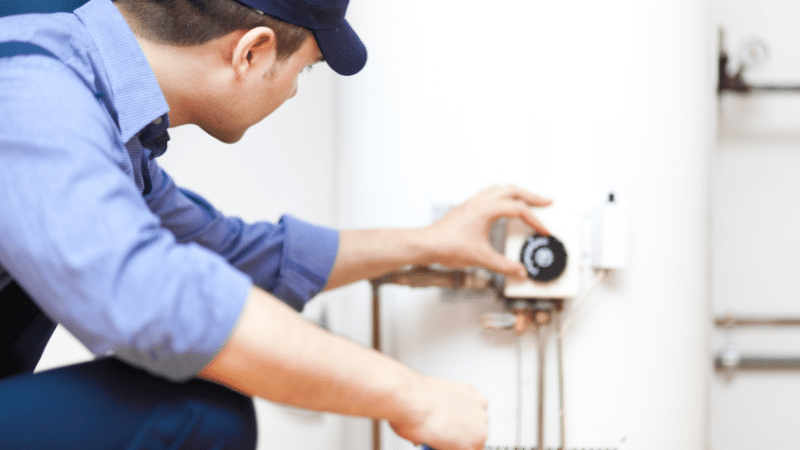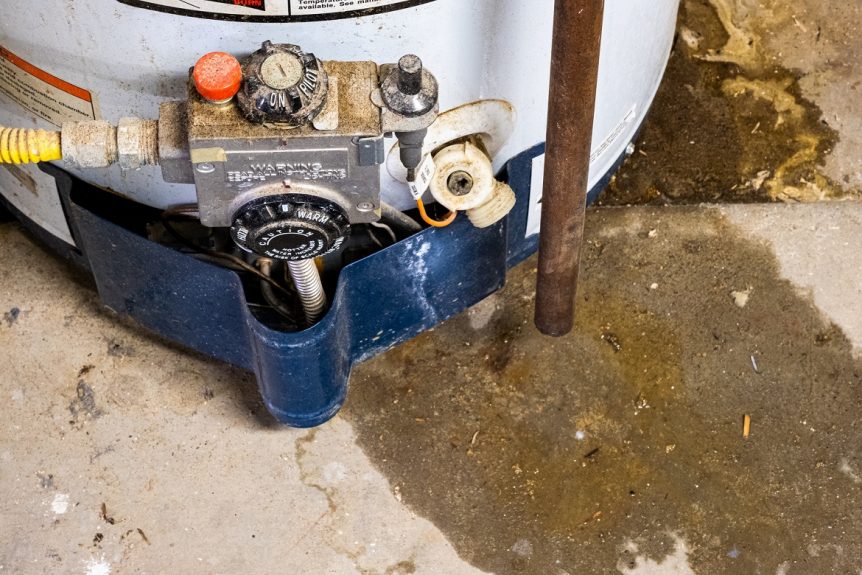A malfunctioning or old water heater can easily leak and cause a basement flood in your home.
Know how to respond to a flood in your basement when a water heater breaks or leaks.
Actions when water heater flooded basement
Drain the Water Heater Tank
Just because the water heater is off, doesn’t mean the leaking will stop.
There are still 40-50 gallons of water in sitting in your typical sized water heater tank. Pressure within the tank will continue to cause this water to leak across your basement floor.
With the supply to the water heater shut off, what you’ll want to do is attach a hose (such as a garden hose) to the faucet or spigot located underneath the tank.
Then, run the hose to a drainage area such as a sink. If you don’t have a sink nearby, be prepared to use buckets!
This can be a slow process. To help drain the water faster, you can open the temperature and pressure valve on your water heater to allow some air in. This will speed up the draining of the tank.
The most common cause of a flood by water heater is due to a broken or burst hose.
Drain the Hot Water from other Pipes

ServiceMaster DRR provides water damage restoration services in San Francisco, CA area. Call us 24/7 at (800) 439-8833 for immediate help.
With the water heater draining, there’s still water elsewhere in the pipes throughout your home.
While your water heater tank drains, the next important step is to turn on hot water at all the faucets in your house. This includes the kitchen sink, shower, and bathroom sinks.
Replace the Water Heater after a Flood
If the leak is coming from the water heater tank, your only real option is unfortunately to replace it altogether.
To resume using cold water while your water heater is out of commission, you will need to remove the water heater unit from the circuit and reconnect the pipes afterward.
This involves some DIY construction efforts. If it seems outside your expertise, this would be the time to consider contacting a plumber or water damage restoration professional.
Dealing with the Aftermath of a Basement Flood
Your water heater may need to be replaced or repaired, but the more pressing issue is all the leaking water in your basement.
If you not cleaned up quickly, you could be facing extensive water damage and even mold growth.
Here are some steps to take after a water heater flood in your basement:
- You should immediately place down towels and blot dry any areas with manageable amounts of water.
- At the very least, open windows and doors, and set up box fans to get some airflow in the basement.
- You will want to rent a shop vac machine to suck up water from the flooring. The kinds that flood restoration professionals use from their trucks are the best around. However, the next best option would be a unit that includes a suction wand.
- If your basement has carpet and has flooded, the carpet will probably need to be pulled out. It’s important to do this before the water can spread further and damage bordering drywall or baseboards.
- Call your homeowner’s insurance and see what can be covered in regards to the water damage.
- Contact a water mitigation company to ensure water is fully extracted and the area is completely dry. Any moisture not properly extracted can cause mold growth in as little as 24 hours.
Fast Response Water Damage Restoration in San Francisco, CA

Water Damage Restoration ServiceMaster
Water damage in any amount is an emergency because it can cause extensive damage to a property if left untreated. That’s why immediate flood cleanup is so critical.
ServiceMaster DRR understands this, which is why we offer 24/7 availability and fast response times to cases of water damage in San Francisco, CA and other nearby cities in California.
A busted water heater that floods your basement isn’t a fun situation to wake up to. Get a water restoration team on the site as soon as you can to mitigate the water damage and to get your basement back to normal.
Call ServiceMaster DRR at (800) 439-8833 for emergency water cleanup in the San Francisco, CA area.

Steve VanDenBerg is the owner of ServiceMaster Disaster Restoration and Recovery. He has over 30 years of experience working within the restoration industry and successfully leading start-ups, turnarounds, acquisitions and mergers, and rapidly growing companies.
Steve earned his BS in Business & Accounting from Calvin University in Grand Rapids, MI and began working for DSI Holdings as their Chief Financial Officer. When Steve began with DSI Holdings, they were running an underperforming ServiceMaster Restore franchise with one location. Steve implemented new policies and procedures for accounting and finance as well as a professional sales plan that increased profits eightfold over his time as the CFO. He was then promoted to President and CEO and in this time, he expanded the company from two locations with $4M in sales to 12 locations and $45M in sales. DSI Holdings became one of the largest disaster restoration companies in the U.S. and helped with major restoration projects throughout the U.S. and around the world.
Steve purchased ServiceMaster DRR in 2015 when the business was in decline. Drawing on his years of experience in turning around struggling ServiceMaster franchises, Steve overhauled our operations, including finance, sales, and marketing, which led to a quick turnaround. Within Steve’s first 24 months, sales increased by 60 percent. Steve also helped greatly improve our operating margins and established a relationship with California’s largest residential insurance company. Under Steve’s leadership, we have become one of the largest disaster restoration providers in California.
Steve has found great success in turning around struggling and stagnant restoration franchises by changing the business model and strategy, greatly increasing sales and profits. Many of the changes he has implemented have even been adopted by the franchisor into their operating model.



